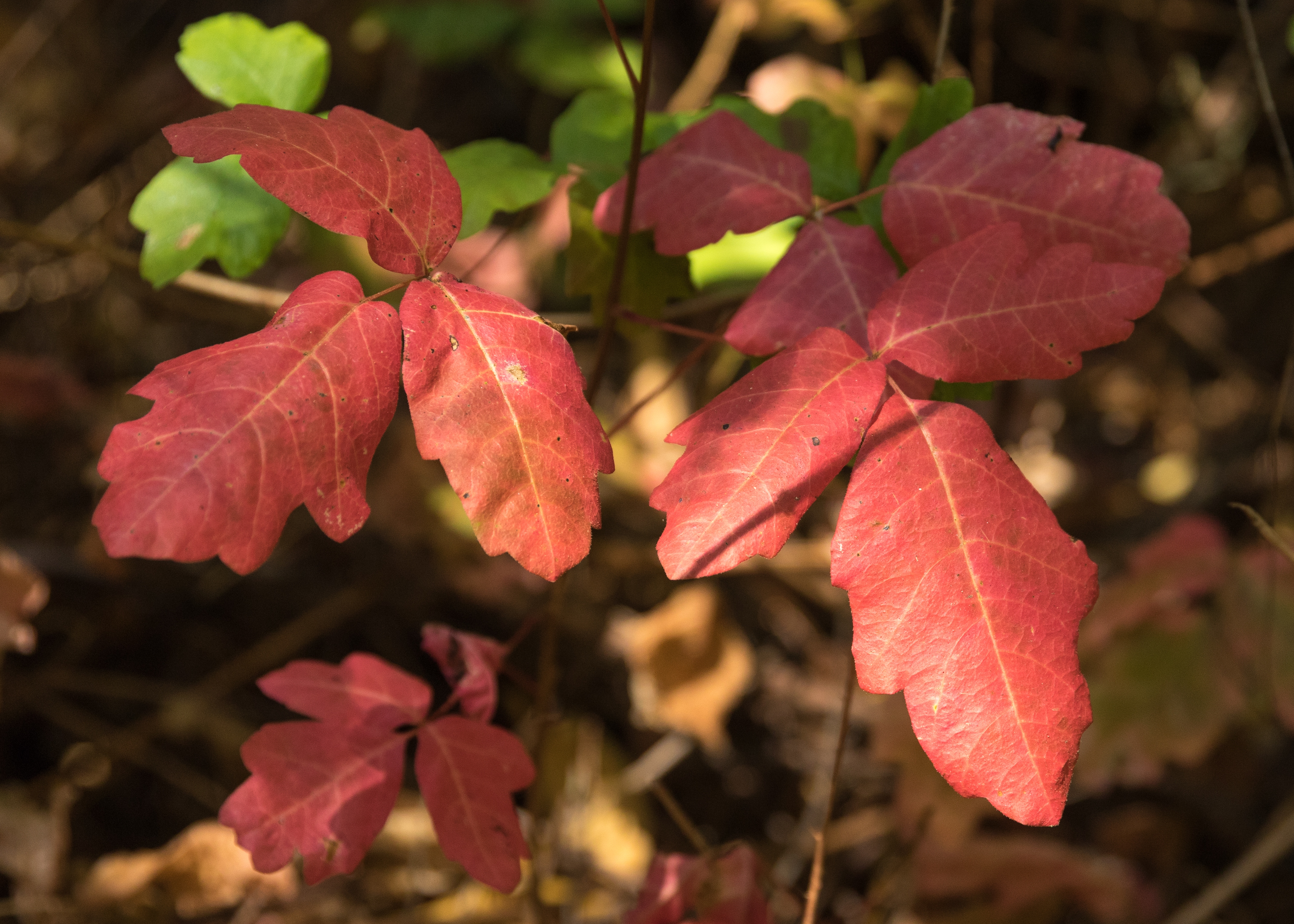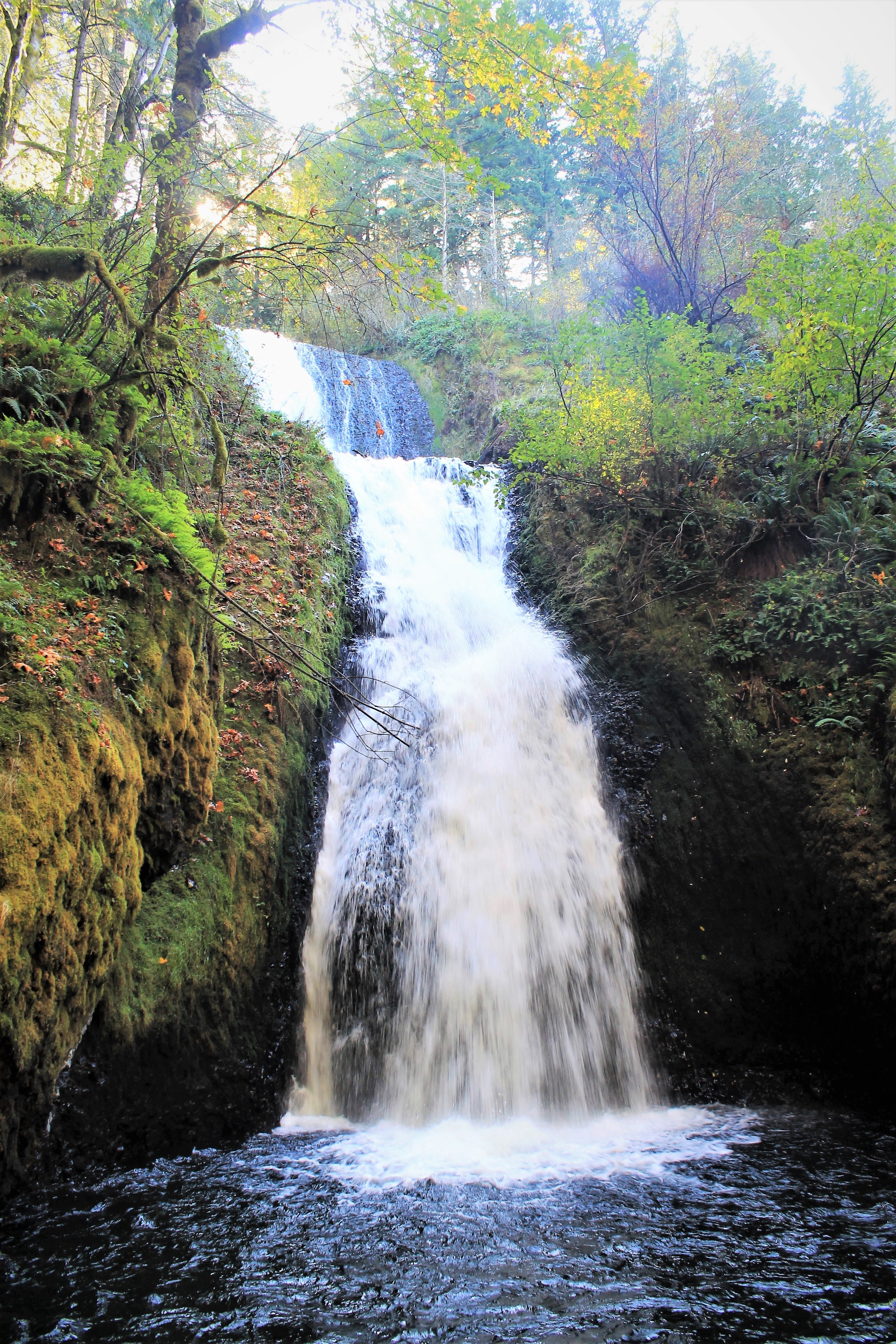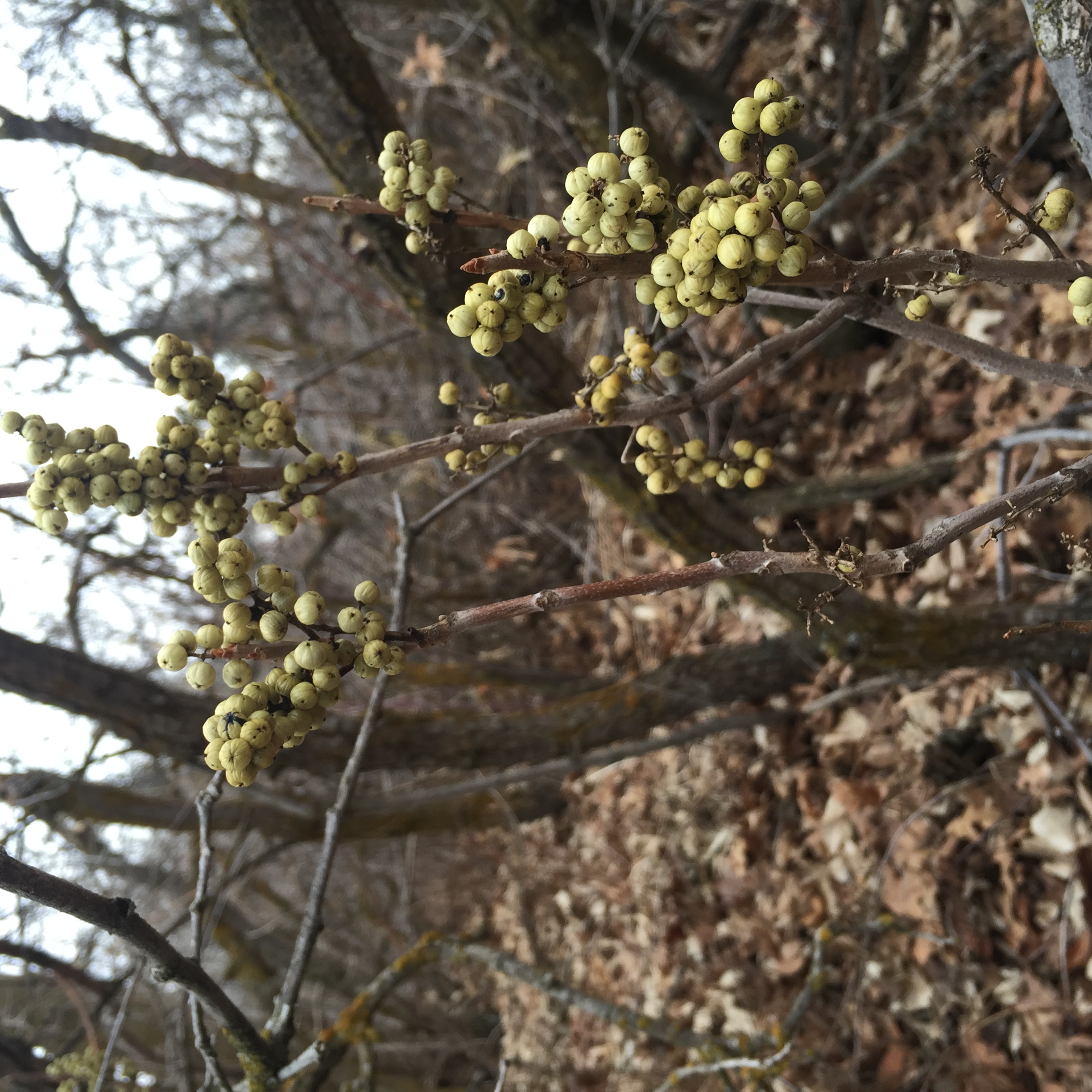|
Western Poison Oak
''Toxicodendron diversilobum'' (syn. ''Rhus diversiloba''), commonly named Pacific poison oak or western poison oak, is a woody vine or shrub in the sumac family, Anacardiaceae. It is widely distributed in western North America, inhabiting conifer and mixed broadleaf forests, woodlands, grasslands, and chaparral biomes.C. Michael Hogan (2008)"Western poison-oak: ''Toxicodendron diversilobum''", GlobalTwitcher, ed. Nicklas Strömberg Peak flowering occurs in May. Like other members of the genus ''Toxicodendron'', ''T. diversilobum'' causes itching and allergic rashes in most people after contact by touch or smoke inhalation. Despite its name, it is not closely related to oaks. Description ''Toxicodendron diversilobum'' is extremely variable in growth habit and leaf appearance. It grows as a dense tall shrub in open sunlight, a treelike vine and may be more than long with an trunk, as dense thickets in shaded areas, or any form in between. It reproduces by spreading r ... [...More Info...] [...Related Items...] OR: [Wikipedia] [Google] [Baidu] |
John Torrey
John Torrey (August 15, 1796 – March 10, 1873) was an American botanist, chemist, and physician. Throughout much of his career, he was a teacher of chemistry, often at multiple universities, while he also pursued botanical work, focusing on the flora of North America. His most renowned works include studies of the New York flora, the Mexican Boundary, the Pacific railroad surveys, and the uncompleted ''Flora of North America''. Biography Torrey was born in New York City, the second child of Capt. William and Margaret (née Nichols) Torrey.Robbins, C. C. (1968). John Torrey (1796–1873), His Life & Times. ''Bulletin of the Torrey Botanical Club''. Vol. 95, No. Nov. 6–Dec. 1968, 515–645. Torrey Botanical Club, New York. He showed a fondness for mechanics, and at one time planned to become a machinist. When he was 15 or 16, his father received an appointment to the state prison at Greenwich Village, New York, where he was tutored by Amos Eaton, then a prisoner a ... [...More Info...] [...Related Items...] OR: [Wikipedia] [Google] [Baidu] |
Yaanga
Yaanga was a large Tongva (or Kizh) village originally located near what is now downtown Los Angeles, just west of the Los Angeles River and beneath U.S. Route 101. People from the village were recorded as ''Yabit'' in missionary records although were known as ''Yaangavit'', ''Yavitam'', or ''Yavitem'' among the people. It is unclear what the exact population of Yaanga was prior to colonization, although it was recorded as the largest and most influential village in the region. Yaangavit were treated as slave laborers during the Mission period by Franciscan padres to construct and work at San Gabriel Mission and ''Nuestra Señora Reina de los Ángeles Asistencia'' and forced laborers for the Spanish, Mexican, and American settlers to construct and expand Los Angeles. The colonizers' dependency on Yaanga for forced labor is thought to be a reason for its ability to survive longer than most Indigenous villages in the region. However, after the founding of Pueblo de Los Ángeles ... [...More Info...] [...Related Items...] OR: [Wikipedia] [Google] [Baidu] |
California Chaparral And Woodlands
The California chaparral and woodlands is a terrestrial ecoregion of southwestern Oregon, northern, central, and southern California (United States) and northwestern Baja California (Mexico), located on the west coast of North America. It is an ecoregion of the Mediterranean forests, woodlands, and scrub biome, and part of the Nearctic realm. Setting Three sub-ecoregions The California chaparral and woodlands ecoregion is subdivided into three smaller ecoregions. * California coastal sage and chaparral ecoregion: In southern coastal California and northwestern coastal Baja California, as well as all the Channel Islands of California and Guadalupe Island. * California montane chaparral and woodlands: In southern and central coast adjacent and inland California, covering some of the mountains of: the Coast Ranges; the Transverse Ranges; and the western slopes of the northern Peninsular Ranges. * California interior chaparral and woodlands: In central interior California su ... [...More Info...] [...Related Items...] OR: [Wikipedia] [Google] [Baidu] |
Riparian Zone
A riparian zone or riparian area is the interface between land and a river or stream. Riparian is also the proper nomenclature for one of the terrestrial biomes of the Earth. Plant habitats and communities along the river margins and banks are called riparian vegetation, characterized by hydrophilic plants. Riparian zones are important in ecology, environmental resource management, and civil engineering because of their role in soil conservation, their habitat biodiversity, and the influence they have on fauna and aquatic ecosystems, including grasslands, woodlands, wetlands, or even non-vegetative areas. In some regions, the terms riparian woodland, riparian forest, riparian buffer zone, riparian corridor, and riparian strip are used to characterize a riparian zone. The word ''riparian'' is derived from Latin '' ripa'', meaning " river bank". Characteristics Riparian zones may be natural or engineered for soil stabilization or restoration. These zones are important na ... [...More Info...] [...Related Items...] OR: [Wikipedia] [Google] [Baidu] |
Columbia River Gorge
The Columbia River Gorge is a canyon of the Columbia River in the Pacific Northwest of the United States. Up to deep, the canyon stretches for over as the river winds westward through the Cascade Range, forming the boundary between the state of Washington to the north and Oregon to the south. Extending roughly from the confluence of the Columbia with the Deschutes River (and the towns of Roosevelt, Washington, and Arlington, Oregon) in the east down to the eastern reaches of the Portland metropolitan area, the water gap furnishes the only navigable route through the Cascades and the only water connection between the Columbia Plateau and the Pacific Ocean. It is thus that the routes of Interstate 84, U.S. Route 30, Washington State Route 14, and railroad tracks on both sides run through the gorge. A popular recreational destination, the gorge holds federally protected status as the Columbia River Gorge National Scenic Area and is managed by the Columbia River Gorge C ... [...More Info...] [...Related Items...] OR: [Wikipedia] [Google] [Baidu] |
Hybrid (biology)
In biology, a hybrid is the offspring resulting from combining the qualities of two organisms of different breeds, varieties, species or genera through sexual reproduction. Hybrids are not always intermediates between their parents (such as in blending inheritance), but can show hybrid vigor, sometimes growing larger or taller than either parent. The concept of a hybrid is interpreted differently in animal and plant breeding, where there is interest in the individual parentage. In genetics, attention is focused on the numbers of chromosomes. In taxonomy, a key question is how closely related the parent species are. Species are reproductively isolated by strong barriers to hybridisation, which include genetic and morphological differences, differing times of fertility, mating behaviors and cues, and physiological rejection of sperm cells or the developing embryo. Some act before fertilization and others after it. Similar barriers exist in plants, with differences in flowering t ... [...More Info...] [...Related Items...] OR: [Wikipedia] [Google] [Baidu] |
Toxicodendron Rydbergii
''Toxicodendron rydbergii'', the western poison ivy, is a species of ''Toxicodendron'' in the cashew family. It is native to most of Canada from the Maritimes to British Columbia, and most of the contiguous United States except the southeastern states, New Jersey, Delaware, and California. It can be found growing in forests, and other wooded areas, usually near streams and rivers. Unlike '' Toxicodendron radicans'' (eastern poison ivy), which often appears as a trailing or climbing vine, ''Toxicodendron rydbergii'' is a shrub that can grow to 1 m (3 ft) tall, rarely up to 3 m (10 ft). The leaves are trifoliate and alternate. The leaflets are variable in size and shape, and are usually 15 cm (6 in) long, turning yellow or orange in autumn. On the compound trifoliate leaves, the two leaflets opposite each other are typically asymmetrical, in contrast to the terminal leaflet which always shows bilateral symmetry. The fruits are small, r ... [...More Info...] [...Related Items...] OR: [Wikipedia] [Google] [Baidu] |
Southeastern United States
The Southeastern United States, also referred to as the American Southeast or simply the Southeast, is a geographical region of the United States. It is located broadly on the eastern portion of the southern United States and the southern portion of the eastern United States. It comprises at least a core of states on the lower East Coast of the United States and eastern Gulf Coast. Expansively, it reaches as far north as West Virginia and Maryland (bordered to north by the Ohio River and Mason–Dixon line), and stretching as far west as Arkansas and Louisiana. There is no official U.S. government definition of the region, though various agencies and departments use different definitions. Geography The U.S. Geological Survey considers the Southeast region to be the states of Alabama, Florida, Georgia, Arkansas, Kentucky, Louisiana, Mississippi, North Carolina, South Carolina, and Tennessee, plus Puerto Rico and the United States Virgin Islands. There is no official Census ... [...More Info...] [...Related Items...] OR: [Wikipedia] [Google] [Baidu] |
Toxicodendron Pubescens
''Toxicodendron pubescens'' (syn. ''Rhus pubescens''), commonly known as Atlantic poison oak, is an upright shrub that can grow to 1 metre (3 feet) tall. Its leaves are 15 centimetres (6 inches) long, alternate, with three leaflets on each. The leaflets are usually hairy and are variable in size and shape, but most often resemble white oak leaves; they usually turn yellow or orange in autumn. The fruit is small, round, and yellowish or greenish. It is not closely related to true oaks. Distribution and habitat This species is native to the Southeastern United States from Virginia westward to |
British Columbia
British Columbia (commonly abbreviated as BC) is the westernmost province of Canada, situated between the Pacific Ocean and the Rocky Mountains. It has a diverse geography, with rugged landscapes that include rocky coastlines, sandy beaches, forests, lakes, mountains, inland deserts and grassy plains, and borders the province of Alberta to the east and the Yukon and Northwest Territories to the north. With an estimated population of 5.3million as of 2022, it is Canada's third-most populous province. The capital of British Columbia is Victoria and its largest city is Vancouver. Vancouver is the third-largest metropolitan area in Canada; the 2021 census recorded 2.6million people in Metro Vancouver. The first known human inhabitants of the area settled in British Columbia at least 10,000 years ago. Such groups include the Coast Salish, Tsilhqotʼin, and Haida peoples, among many others. One of the earliest British settlements in the area was Fort Victoria, established ... [...More Info...] [...Related Items...] OR: [Wikipedia] [Google] [Baidu] |
Washington (state)
Washington (), officially the State of Washington, is a state in the Pacific Northwest region of the Western United States. Named for George Washington—the first U.S. president—the state was formed from the western part of the Washington Territory, which was ceded by the British Empire in 1846, by the Oregon Treaty in the settlement of the Oregon boundary dispute. The state is bordered on the west by the Pacific Ocean, Oregon to the south, Idaho to the east, and the Canadian province of British Columbia to the north. It was admitted to the Union as the 42nd state in 1889. Olympia is the state capital; the state's largest city is Seattle. Washington is often referred to as Washington state to distinguish it from the nation's capital, Washington, D.C. Washington is the 18th-largest state, with an area of , and the 13th-most populous state, with more than 7.7 million people. The majority of Washington's residents live in the Seattle metropolitan area, the center o ... [...More Info...] [...Related Items...] OR: [Wikipedia] [Google] [Baidu] |
Oregon
Oregon () is a state in the Pacific Northwest region of the Western United States. The Columbia River delineates much of Oregon's northern boundary with Washington, while the Snake River delineates much of its eastern boundary with Idaho. The 42° north parallel delineates the southern boundary with California and Nevada. Oregon has been home to many indigenous nations for thousands of years. The first European traders, explorers, and settlers began exploring what is now Oregon's Pacific coast in the early-mid 16th century. As early as 1564, the Spanish began sending vessels northeast from the Philippines, riding the Kuroshio Current in a sweeping circular route across the northern part of the Pacific. In 1592, Juan de Fuca undertook detailed mapping and studies of ocean currents in the Pacific Northwest, including the Oregon coast as well as the strait now bearing his name. Spanish ships – 250 in as many years – would typically not land before reaching Cape Mendoci ... [...More Info...] [...Related Items...] OR: [Wikipedia] [Google] [Baidu] |










.jpg)